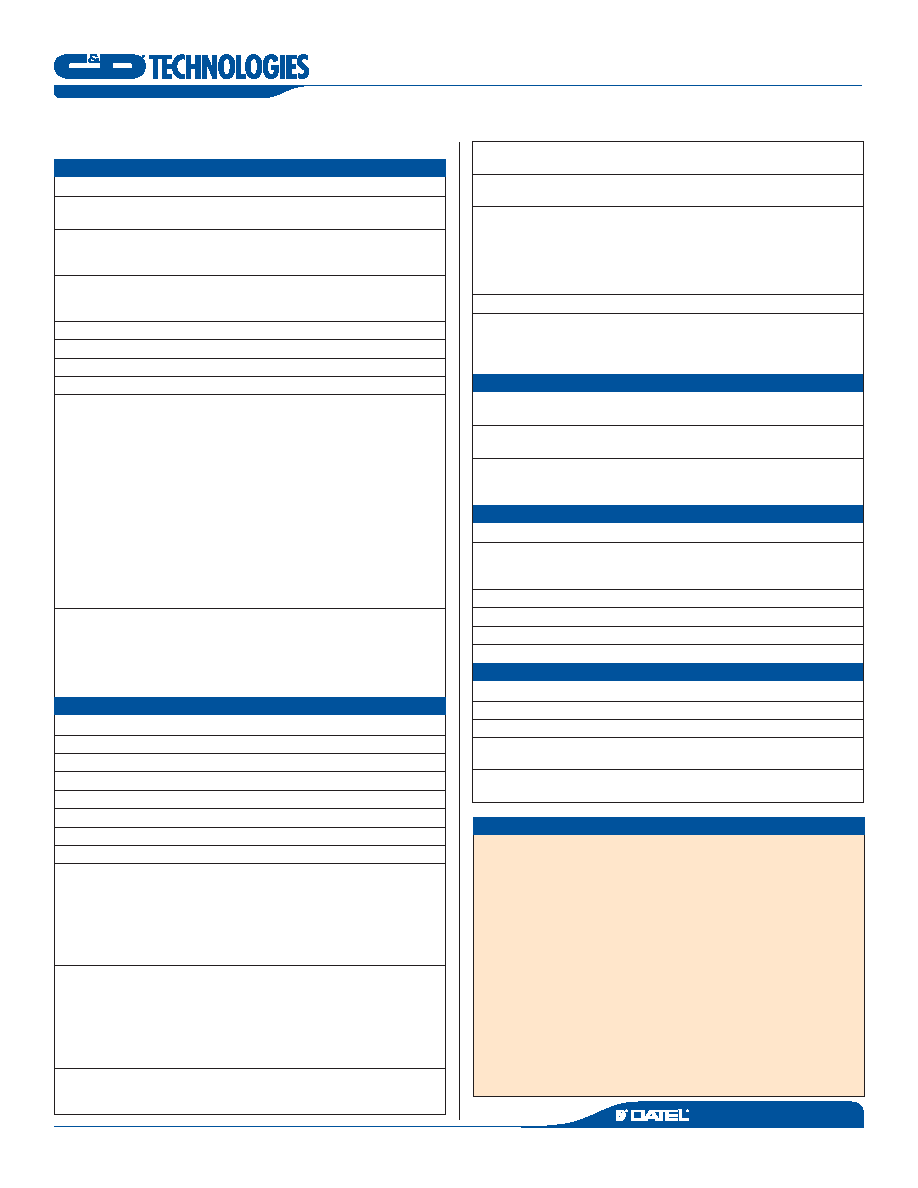- 您現(xiàn)在的位置:買賣IC網(wǎng) > PDF目錄30763 > LSM2-T/6-W3-C 1-OUTPUT 19.8 W DC-DC REG PWR SUPPLY MODULE PDF資料下載
參數(shù)資料
| 型號: | LSM2-T/6-W3-C |
| 元件分類: | 電源模塊 |
| 英文描述: | 1-OUTPUT 19.8 W DC-DC REG PWR SUPPLY MODULE |
| 封裝: | ROHS COMPLIANT |
| 文件頁數(shù): | 11/17頁 |
| 文件大?。?/td> | 1394K |
| 代理商: | LSM2-T/6-W3-C |

LSM2 Series
Single Output, Non-isolated, Selectable-Output POL DC/DC Converters
MDC_LSM2_A01 Page 3 of 7
P O W E R E L E C T R O N I C S D I V I S I O N
D C / D C C O N V E R T E R S
www.cd4power.com
Performance/Functional Specifications ()
INPUT
Input Voltage Range
See Ordering Guide
Isolation
Not isolated, input and output commons
are internally connected
Start-Up Threshold
W3 Models
2.2 Volts
2V Models
8 Volts
Undervoltage Shutdown
W3 Models
2.0 Volts
2V Models
7.5 Volts
Overvoltage Shutdown
None
Reflected (Back) Ripple Current (2)
20-70mAp-p (model dependent)
Internal Input Filter Type
Capacitive
Reverse Polarity Protection
See fuse information
Input Current:
Full Load Conditions
See Ordering Guide
Inrush Transient
0.-0.4A2sec (model dependent)
Shutdown Mode (Off, UV, OT)
5mA
Output Short Circuit
60mA
No Load
W3 models
50mA
2V models
00mA
Low Line (VIN = VMIN)
LSM2-T/6-W3
5.54 Amps
LSM2-T/6-D2
3.79 Amps
LSM2-T/0-W3
9.4 Amps
LSM2-T/0-D2
6.3 Amps
LSM2-T/6-W3
4.63 Amps
LSM2-T/6-D2
0.2 Amps
Remote On/Off Control: (5)
Positive Logic (no model suffix)
OFF = ground pin to +0.3V max.
ON = open pin or +VIN max.
Negative Logic (“N” model suffix)
ON = ground pin to +0.3V max.
OFF = open pin to +VIN max.
Current
mA max.
OUTPUT
Voltage Output Range
See Ordering Guide
Minimum Loading
No minimum load
Accuracy (50% load)
±2% of VNOM
Voltage Adjustment Range (3)
See Ordering Guide
Temperature Coefficient
±0.02% of VOUT range per °C
Ripple/Noise (20 MHz bandwidth)
See Ordering Guide and (8)
Line/Load Regulation (See Tech Notes) See Ordering Guide and (0)
Efficiency
See Ordering Guide
Maximum Capacitive Loading: (4)
LSM2-T/6 models:
Cap-ESR = 0.00 to 0.0
W
3000F
Cap-ESR >0.0
W
5000F
LSM2-T/0 and -T/6 models:
Cap-ESR = 0.00 to 0.0
W
5000F
Cap-ESR >0.0
W
0,000F
Current Limit Inception: (98% of VOUT)
LSM2-T/6 models
Amps (cold startup)
0 Amps (after warm up)
LSM2-T/0 models
8.75 Amps (cold startup)
6.75 Amps (after warm up)
LSM2-T/6 models
24 Amps (cold startup)
2 Amps (after warm up)
Short Circuit Mode (6)
Short Circuit Current Output
600mA
Protection Method (6)
Hiccup autorecovery on overload removal
Short Circuit Duration
Continuous, no damage (output shorted
to ground)
Prebias Startup (5)
Converter will start up if the external
output voltage is less than VNOM
Sequencing
Slew Rate
2V max. per millisecond
Startup delay until sequence start
0 milliseconds
Tracking accuracy, rising input
VOUT = ±00mV of Sequence In
Tracking accuracy, falling input
VOUT = ±200mV of Sequence In
Sequence pin input impedance
400k
W to MW
Remote Sense to VOUT
0.5V max. (7)
Power Good Output (7)
TRUE (OK) = open drain
(“G” suffix)
FALSE (not OK) = Signal Ground to 0.4V
Power_Good Configuration
MOSFET to ground with external user
pullup, 0mA max. sink
DYNAMIC CHARACTERISTICS
Dynamic Load Response
25sec to ±2% of final value
(50-00-50% load step, di/dt = 20A/msec)
Start-Up Time
7msec for VOUT = nominal
(VIN on to VOUT regulated or On/Off to VOUT)
Switching Frequency
LSM2-T/6 models
35kHz
LSM2-T/0 and -T/6 models
230kHz
ENVIRONMENTAL
Calculated MTBF (4)
TBC Hours
Operating Temperature Range (Ambient)
No derating, natural convection
–40 to +63°C (9)
With derating
See Derating Curves
Operating PC Board TemUperature
–40 to +00°C max. (2)
Storage Temperature Range
–55 to +25°C
Thermal Protection/Shutdown
+5°C
Relative Humidity
to 85% / +85°C, non-condensing
PHYSICAL
Outline Dimensions
See Mechanical Specifications
Removable Heat Shield
Nylon 46
Weight
0.28 ounces (7.8 grams)
Electromagnetic Interference
FCC part 5, class B, EN55022 (may
(conducted and radiated)
need external filter)
Safety
UL/cUL 60950 CSA-C22.2 No.234
IEC/EN 60950
ABSOLUTE MAXIMUM RATINGS
Input Voltage (Continuous or transient)
W3 models
+7 Volts
2V models
+5 Volts
On/Off Control
–0.3V min. to +VIN max.
Input Reverse Polarity Protection
See Fuse section
Output Current (7)
Current-limited. Devices can
withstand sustained short circuit
without damage.
Storage Temperature
–55 to +25°C
Lead Temperature (soldering 0 sec. max.) +280°C
These are stress ratings. Exposure of devices to any of these conditions may adversely affect
long-term reliability. Proper operation under conditions other than those listed in the Perfor-
mance/Functional Specifications Table is not implied.
相關(guān)PDF資料 |
PDF描述 |
|---|---|
| LSM2-T/6-W3G-C | 1-OUTPUT 19.8 W DC-DC REG PWR SUPPLY MODULE |
| LSM2-T/6-D12-C | 1-OUTPUT 19.8 W DC-DC REG PWR SUPPLY MODULE |
| LSM2-T/6-D12G-C | 1-OUTPUT 19.8 W DC-DC REG PWR SUPPLY MODULE |
| LSN-1.2/16-W3J | 1-OUTPUT DC-DC REG PWR SUPPLY MODULE |
| LSN-1.5/16-W3J | 1-OUTPUT DC-DC REG PWR SUPPLY MODULE |
相關(guān)代理商/技術(shù)參數(shù) |
參數(shù)描述 |
|---|---|
| LSM2U | 功能描述:限位開關(guān) LIMIT SWITCH RoHS:否 制造商:Honeywell 觸點形式:SPDT 執(zhí)行器:Non-Contact 電流額定值:30 mA 電壓額定值 AC: 電壓額定值 DC:3.6 V 工作力:10 g IP 等級:IP 67 NEMA 額定值:1, 4, 12, 13 端接類型:4-Pin M12 Connector 安裝:SMD/SMT |
| LSM-3.3/10-D12 | 功能描述:DC/DC轉(zhuǎn)換器 33W 12V to 3.3V 10A SMT Package RoHS:否 制造商:Murata 產(chǎn)品: 輸出功率: 輸入電壓范圍:3.6 V to 5.5 V 輸入電壓(標稱): 輸出端數(shù)量:1 輸出電壓(通道 1):3.3 V 輸出電流(通道 1):600 mA 輸出電壓(通道 2): 輸出電流(通道 2): 安裝風格:SMD/SMT 封裝 / 箱體尺寸: |
| LSM-3.3/10-D12-C | 功能描述:DC/DC轉(zhuǎn)換器 33W 12V to 3.3V 10A RoHS:否 制造商:Murata 產(chǎn)品: 輸出功率: 輸入電壓范圍:3.6 V to 5.5 V 輸入電壓(標稱): 輸出端數(shù)量:1 輸出電壓(通道 1):3.3 V 輸出電流(通道 1):600 mA 輸出電壓(通道 2): 輸出電流(通道 2): 安裝風格:SMD/SMT 封裝 / 箱體尺寸: |
| LSM-3.3/10-D12EB | 制造商:MURATA 制造商全稱:Murata Manufacturing Co., Ltd. 功能描述:10 Amp DC/DC Power Converter Evaluation Boards |
| LSM-3.3/10-D5 | 功能描述:DC/DC轉(zhuǎn)換器 33W 5V to 3.3V 10A SMT Package RoHS:否 制造商:Murata 產(chǎn)品: 輸出功率: 輸入電壓范圍:3.6 V to 5.5 V 輸入電壓(標稱): 輸出端數(shù)量:1 輸出電壓(通道 1):3.3 V 輸出電流(通道 1):600 mA 輸出電壓(通道 2): 輸出電流(通道 2): 安裝風格:SMD/SMT 封裝 / 箱體尺寸: |
發(fā)布緊急采購,3分鐘左右您將得到回復。